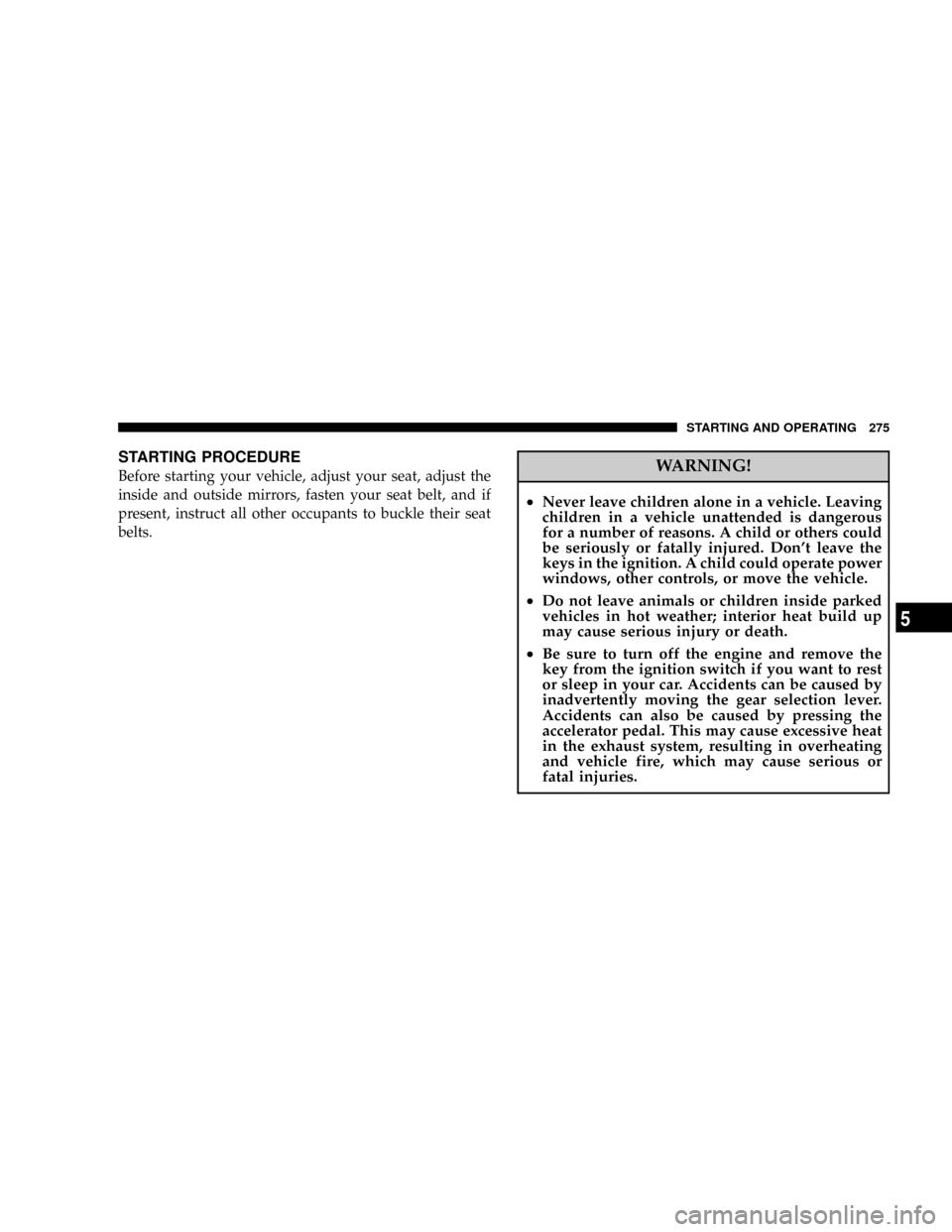Page 261 of 490

located on the control panel. Conditioned air will be
directed through the outlets selected by the mode control.
A light in the snowflake button shows that the air
conditioning is on.
Slight changes in engine speed or power may be noticed
when the air conditioning compressor is on. This is a
normal occurrence as the compressor will cycle on and
off to maintain comfort and increase fuel economy.
Automatic Temperature Control Ð If Equipped
The Infrared Dual-Zone Climate Control System auto-
matically maintains the interior comfort level desired by
the driver and passenger. This is accomplished by a dual
sun-sensor in the top of the instrument panel, and an
infrared sensor located in the face of the control unit.
There are also various sensors monitored by this system
which take account for vehicle speed, A/C pressure,
outside temperature, and engine cooling temperature.
The infrared sensor independently measures the surfacetemperature of the driver and passenger. Based on the
sensor input, the system automatically adjusts the air
flow temperature, the air flow volume, and amount of
outside air recirculation. This maintains a comfortable
temperature even under changing conditions.
Automatic Temperature Controls
UNDERSTANDING YOUR INSTRUMENT PANEL 261
4
Page 263 of 490

The system will automatically control recircu-
lation. However, pressing this button will tem-
porarily put the system in recirculation mode.
This can be used when outside conditions such
as smoke, odors, dust, or high humidity are present. This
will cause the LED to illuminate.
NOTE:
²The surface of the climate control panel, and the top
center of the instrument panel should be kept free of
debris due to the climate control sensor's location.
Mud on the windshield may also cause poor operation
of this system.
²To provide you with maximum comfort in the auto-
matic mode, during cold start-ups the blower fan will
remain off until the engine warms up. However, the
fan will engage immediately if the defrost mode is
selected or if you manually select a blower speed.
²Under certain conditions (after the vehicle is turned
off) the climate control system may recalibrate and a
noise may be heard for 20 seconds. This is part of
normal operation.
²Most of the time, when in Automatic operation, you
can temporarily put the system into recirculation
mode by pressing the Recirc button. However, under
certain conditions in automatic the system is blowing
air out of the defrost vents. When these conditions are
present and the Recirc button is pressed the indicator
will flash and remain off. This tells you that you are
unable to go into recirculation mode at this time. If you
would like to go to Recirculation mode, you must first
move your mode knob to panel, panel/floor or floor,
then hit the Recirc button. This feature will reduce the
possibility of window fogging.
UNDERSTANDING YOUR INSTRUMENT PANEL 263
4
Page 268 of 490

Operating Tips
Window Fogging
Windows will fog on the inside when the humidity inside
the vehicle is high. This often occurs in mild or cool
temperatures when it's rainy or humid. In most cases
turning on the Air-conditioning (pressing the snowflake
button) will clear the fog. Adjust the temperature control,
air direction and blower speed to maintain comfort.
As the temperature gets colder it may be necessary to
direct air onto the windshield. Adjust the temperature
control and blower speed to maintain comfort. Higher
blower speeds will reduce fogging. Interior fogging on
the windshield can be quickly removed by selecting the
defrost mode.
Regular cleaning of the inside of the windows with a
non-filming cleaning solution (vinegar and water works
very well) will help prevent contaminates (cigarettesmoke, perfumes, etc.) from sticking to the windows.
Contaminates increase the rate of window fogging.Summer Operation
Air conditioned vehicles must be protected with a high
quality antifreeze coolant during summer to provide
proper corrosion protection and to raise the boiling point
of the coolant for protection against overheating. A 50 %
concentration is recommended. Refer to Recommended
Fluids and Genuine Parts for the proper coolant type.
When using the air conditioner in extremely heavy traffic
in hot weather especially when towing a trailer, addi-
tional engine cooling may be required. If this situation is
encountered, operate the transmission in a lower gear to
increase engine RPM, coolant flow and fan speed. When
stopped in heavy traffic, it may be necessary to shift into
N (Neutral) and depress the accelerator slightly for fast
idle operation to increase coolant flow and fan speed.
268 UNDERSTANDING YOUR INSTRUMENT PANEL
Page 271 of 490
STARTING AND OPERATING
CONTENTS
mStarting Procedure......................275
NNormal Starting Ð Gasoline Engines.......276
NExtremely Cold Weather (Below220ÉF Or
229ÉC).............................276
NIf Engine Fails To Start.................277
NAfter Starting........................278
NNormal Starting Ð Diesel Engines.........278
mEngine Block Heater Ð If Equipped.........283
mAutomatic Transmission..................284NShift Lock Manual Override Ð If Equipped . . . 284
NBrake/Transmission Interlock System.......285
N5±Speed Automatic Transmission..........285
NGear Ranges.........................286
NRocking The Vehicle...................292
mFour-Wheel Drive Operation...............293
NQuadra-Trac ItOperating Instructions/
Precautions Ð If Equipped..............293
NQuadra-Trac IItOperating
Instructions/Precautions Ð If Equipped.....293
5
Page 272 of 490

NShift Positions........................295
NShifting Procedures....................296
NQuadra-Drive IItSystem Ð If Equipped.....299
mOn-Road Driving Tips...................299
mOff-Road Driving Tips...................300
NWhen To Use 4WD Low Range Ð
If Equipped.........................300
NDriving Through Water.................300
NDriving In Snow, Mud And Sand..........301
NHill Climbing........................301
NTraction Downhill.....................302
NAfter Driving Off-Road.................303
mParking Brake.........................304mAnti-Lock Brake System..................305
mPower Steering........................308
mMulti Displacement System (MDS) Ð 5.7L Engine
Only................................309
mTire Safety Information...................310
NTire Markings........................310
NTire Identification Number (TIN)..........313
NTire Loading And Tire Pressure...........314
mTires Ð General Information...............318
NTire Pressure.........................318
NTire Inflation Pressures.................319
NTire Pressures For High Speed Operation....321
NRadial-Ply Tires......................321
272 STARTING AND OPERATING
Page 273 of 490

NTire Spinning........................321
NTread Wear Indicators..................322
NLife Of Tire.........................323
NReplacement Tires.....................323
NAlignment And Balance.................324
mTire Chains...........................325
mTire Rotation Recommendations............325
mTire Pressure Monitor System (TPMS)........326
NBase System Ð If Equipped..............329
NPremium System Ð If Equipped..........331
NGeneral Information...................336
mFuel Requirements......................336
N3.7/4.7L Engines (If Equipped)............336N5.7L Engines (If Equipped)...............337
NReformulated Gasoline.................337
NGasoline/Oxygenate Blends..............338
NMMT In Gasoline.....................338
NMaterials Added To Fuel................339
NFuel System Cautions..................339
NCarbon Monoxide Warnings..............340
mFlexible Fuel (4.7L Engine Only) Ð
If Equipped...........................340
NE-85 General Information................340
NEthanol Fuel (E-85)....................341
NFuel Requirements....................342
NSelection Of Engine Oil For Flexible Fuel
Vehicles (E-85) And Gasoline Vehicles.......343
STARTING AND OPERATING 273
5
Page 274 of 490

NStarting............................343
NCruising Range.......................343
NReplacement Parts.....................343
mFuel Requirements (Diesel Engines)..........344
mAdding Fuel..........................345
NFuel Filler Cap (Gas Cap)...............346
mVehicle Loading........................348
NCertification Label.....................348
mTrailer Towing.........................351
NCommon Towing Definitions.............351
NTrailer Hitch Classification...............354NTrailer Towing Weights (Maximum Trailer
Weight Ratings)......................355
NTrailer And Tongue Weight..............357
NTowing Requirements..................358
NTowing Tips.........................362
mRecreational Towing (Behind Motorhome, Etc.) . . 364
NTowing ± 2WD Models.................364
NTowing Ð Quadra-Trac I (Single-Speed Transfer
Case) 4WD Models....................364
NTowing Ð Quadra±Trac II /Quadra±Drive II
4WD Models........................364
mSnow Plow...........................368
274 STARTING AND OPERATING
Page 275 of 490

STARTING PROCEDURE
Before starting your vehicle, adjust your seat, adjust the
inside and outside mirrors, fasten your seat belt, and if
present, instruct all other occupants to buckle their seat
belts.WARNING!
²Never leave children alone in a vehicle. Leaving
children in a vehicle unattended is dangerous
for a number of reasons. A child or others could
be seriously or fatally injured. Don't leave the
keys in the ignition. A child could operate power
windows, other controls, or move the vehicle.
²Do not leave animals or children inside parked
vehicles in hot weather; interior heat build up
may cause serious injury or death.
²Be sure to turn off the engine and remove the
key from the ignition switch if you want to rest
or sleep in your car. Accidents can be caused by
inadvertently moving the gear selection lever.
Accidents can also be caused by pressing the
accelerator pedal. This may cause excessive heat
in the exhaust system, resulting in overheating
and vehicle fire, which may cause serious or
fatal injuries.
STARTING AND OPERATING 275
5